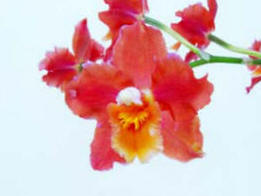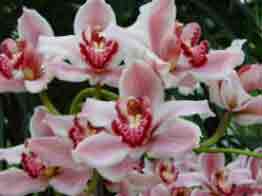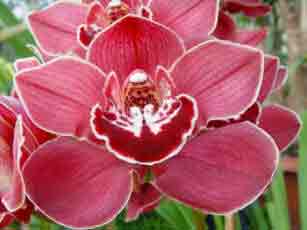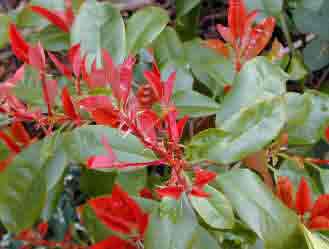Caring for Orchids - Care Advice about Phalaenopsis, Cambrian and Cymbidiums
At this time of year, many people start hungering for the fresh colours and scents of the great outdoors. If you’re tired of the usual narcissus that you’ve had blooming since Christmas, it may be time to try your hand at growing orchids indoors. Follow our advice for successful orchid growing.
Orchids have a reputation for being difficult to cultivate, but with a little knowledge and by following our caring for orchids advice tips, you’ll find you can keep one alive fairly easily, as long as you give the plant what it wants and needs. And you don’t need a privately-endowed trust fund for the plants, either. Today, you can buy orchids at many discount home or gardening stores for not much more than other flowering houseplants.


Left - Cambrian Orchid Right - Cymb idium
Not only are these flowers beautiful, coming in a great variety of colours, shapes and scents, but the plants themselves seem otherworldly. Most people wonder, “How can I possibly care and grow this plant in a pot, when in nature it grows hanging off a tree branch?”
The reason you can, is that most popular cultivated orchids are epiphytes, or air plants, which most often grow on trees or the surfaces of rocks. Their roots are usually exposed to air and get nutrients chiefly when it rains. As a result, these varieties are not grown in soil: they should be grown in pots full of tree bark, with some crumbled charcoal. (If you have a humid greenhouse, you can grow them attached to wood or cork plaques, but don’t try this in your windowsill just yet!)


Cymbidium
Phalaenopsis
Caring for Orchids
There are many popular types of orchid, including
Cattleyas,
Dendrobiums,
Oncidiums,
vandas. Phalaenopsis,
which are popularly known as the “moth orchids,” are
commonly recommended for most beginners. As testament to
the great variety of orchids, there are over 70 species
in the genus, and there are probably several thousand
named hybrids. Currently this is the easiest one to find
at the florist shop, the greenhouse, or the plant fair,
and the one that most people immediately recognize as an
orchid. Surprisingly, there is not much advice about
caring for orchids.
First, when choosing an individual plant, look for
clean, shiny leaves, and don’t worry if you see some
roots out of the mix; the roots like being exposed to
the air, and should look healthy and plump, not
broken-up and spindly. Next, it is always best to buy a
plant already in flower so you see what you are getting
— this way you’ll see the colour and you’ll verify that
you have a healthy, mature plant capable of having
flowers.
Once you get the plant home, you need to make sure your
phalaenopsis is happy with the amount of light it’s
getting. Too much light, and the leaves will turn
yellow; too little, and the leaves will be dark green,
and the plant itself will start looking scrawny and
won’t flower. Phalaenopsis prefer medium amounts of
not-too-bright sunshine, as found in most east- or
west-facing windows.
When Europeans first began cultivating orchids, they
thought that because orchids were native to hot, humid
climates, they had to have round-the-clock heat and
humidity. In reality, like many other popular orchids,
phalaenopsis are rather ideally suited to a bright
window in a home in a temperate climate; they like
daytime temperatures of about 80 degrees F, and night
time temperatures of about 60 degrees. It’s the change
in temperature that’s crucial for successfully growing
most orchids; if there isn’t enough of a temperature
drop at night, the orchids may not bloom.
Phalaenopsis Orchids Advice
While phalaenopsis don’t need lots of heat, they do need a level of
humidity that isn’t found in most homes outside of a rainforest. To
supplement the humidity in your home, you can use a room humidifier, or
a smaller humidifier that will just keep the area around the plants
moist. Also, many indoor growers keep their orchids above a “humidity
tray” instead of using saucers under the pots. The runoff from watering
your plants goes into the tray and evaporates, providing extra humidity.
Try to keep your phalaenopsis watered. Don’t let the potting medium dry
out completely, but water the plant whenever the medium gets to the
point of being only slightly damp. That said, one of the most common
ways of killing an orchid is by overwatering. To prevent this, check the
weight of the pot every day. Right after you water, the pot should be
heavy; when dry, the pot will be light. Note how long it takes for the
pot to become dry and then water every few days as necessary. Small pots
will dry out faster than larger ones. Since most home windowsills are
not very humid, you should use plastic pots, which help retain moisture.
Most commercial orchid potting medium is made of tree bark mixed with
charcoal and perlite chunks. If it turns out you suffer from the common
inclination to overwater, you should use a coarser grade of mix when you
re-pot. Overwatering will eventually kill your plant, since the roots
will be robbed of the air they need.
Use houseplant food with a “balanced” ratio of 18 nitrogen, 18
phosphorous and 18 potassium, or any similar formula. Only use about ½
to ¼ the amount per gallon that is recommended on the package, since
orchids don’t need as much of this food as other plants who are fed with
this 18-18-18 mix.
If just a lone orchid sitting in the window isn’t decorative enough for
you, put the pot in a pretty cachepot or jardinière to add visual
interest. Always use a waterproof container! And make sure to put at
least an inch of pebbles in the bottom so the plant won’t sit in water.
(Better yet, take the plant and pot out of the decorative container when
you water, and put it back after it has drained.)
Orchids grow well with other houseplants. Also, grouping plants
attractively in the window has an unexpected benefit: extra humidity for
the orchids!
Since orchids flower in a variety of colours, you’re sure to find a
variety you can grow with a bloom that can complement the other
accessories in your home.
Not only are orchids a lovely way to add colour to your home, but they
also have a fascinating history. Starting about 4,000 years ago, the
Chinese word for orchids--“lan”-- appeared in written texts about herbal
medicine. Confucius wrote about orchids, comparing the pleasure of
seeing good friends to entering a room full of fragrant orchids.
Meanwhile, in Europe native terrestrial orchids were used as
aphrodisiacs.
The 19th century European frenzy of exploration, combined with the
growing Western interest in tropical orchids, drove orchid prices up and
drove many people to explore the tropics to collect more of the exotic
plants. Unfortunately, this collecting spree led to considerable orchid
habitat destruction, and many species were probably lost forever as a
result. Today, many orchidists - including the American Orchid Society -
advocate the purchase of artificially propagated orchids, either
meristem clones or seedlings, which will help discourage the collecting
of orchid species at home and abroad.
The family of orchids is the largest plant family, with a great deal of
variety as well, from miniatures such as Mystacidium caffrum to the
20-foot-tall Renanthera storei. Some orchids have tiny blooms smaller
than a pinhead; others are bigger than an Easter lily. Some orchids
bloom continuously, others bloom just once a year. Orchids are
beautiful, interesting plants that are sure to enrich your life and
bring a little tropical warmth into your winter home.
Below are some other page links for caring for orchids.
Oncidium Orchids
: x Ascocenda Orchids :
Dendrobium Orchids :
Vanda Orchids
Best Selling Gardening Products
Popular Gardening Sections

Problems
Identify Weeds in The Garden - How to deal with weeds. Diseases and Pest which harm your garden and plants, learn how to prevent, deter and erradicate your garden problems.
Garden Problems
Pruning
Pruning Guide. Shrubs flower better with correct pruning. Many illustrations and examples of what to do - and when. Includes evergreens, roses, flowering shrubs, spring flowering shrubs and pruning for stem effect. This is our most viewed and comprehensive section,
Pruning
Gardening Businesses
Gardening Businesses listed in the UK counties and USA states. County and State Listings of businesses involved in Garden supplies and services. If you wish to be added to the Directory, please send us your information. Having problems, use the search box
Businesses
Gardening
In this section you will learn about Gardening Basics, Containers, Landscaping, Propagation and Soil.
Gardening
Gardening Gifts
Gardening Gifts and Reviews, Read Before you Buy
- Gardening Gifts Ideas
- Gifts For Her
- Gifts For Men
- Power Tool Gifts
- Cheap Gifts
- Personalised Gifts
- Wildlife Gifts
- Family Gifts



